US Dollar Exchange Rates of
25th
April
2020
China Yuan 7.0819
Report from China
Housing sales in the first quarter down 8%
In a press release the National Bureau of Statistics reports
that in the first quarter 2020 investment in real estate
dropped almost 8% year on year. However, China¡¯s
residential housing market began a steady revival in
March as real estate companies reopened across the
country following the easing of the nationwide shutdown.
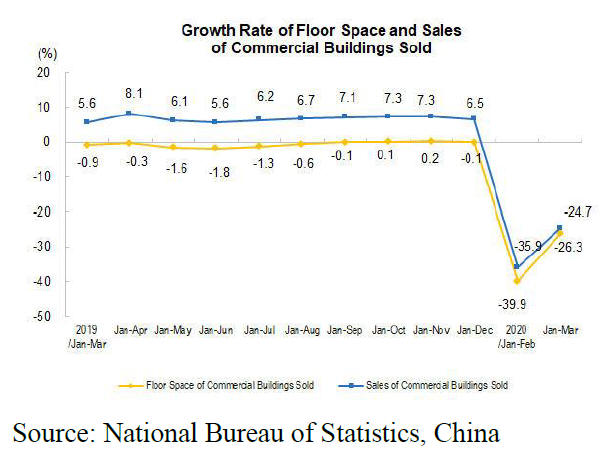
Sales in eight of the large cities jumped to levels
well
above that in the last quarter of 2019 before the virus
outbreak caused a shut-down. The beginning of a recovery
is a relief to the industry which has been offering buyers
heavy discounts to boost sales. A lively housing market is
good for timber sales and for sales of furniture.
See:
http://www.stats.gov.cn/english/PressRelease/202004/t20200420_1739751.html
Furniture retailers will be welcoming the recovery in the
housing market as they have seen furniture sales drop
almost 30% in the first quarter 2020. In March, retail sales
of consumer goods were down almost 16% year-on-year.
See:
http://www.stats.gov.cn/english/PressRelease/202004/t20200420_1739765.html
Decline in China¡¯s imports of tropical hardwood logs
China¡¯s log imports in the first two months of 2020
totalled 7.73 million cubic metres valued at US$1,104
million, a year on year decline of 9% in volume and 27%
in value.
Of total log imports, softwood log imports fell 7% to 5.49
million cubic metres and accounted for 71% of total log
imports. Hardwood log imports fell 15% to 2.24 million
cubic metres (29% of total log imports).
Of total hardwood log imports, tropical log imports were
1.30 million cubic metres valued at US$3.25 million,
down 26% in volume and 37% in value from the same
period of 2019.
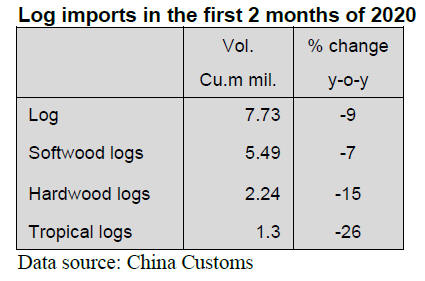
Germany the second largest log supplier
Among supply countries providing more than 100,000
cubic metres of log imports in the first two months of 2020
were Germany and the Czech Republic where imports
soared over 250% and 300% respectively and to 1.11
million cubic metres and 393,000 cubic metres
respectively. In 2019, around 12 million cubic metres of
standing timber in North Rhine-Westphalia alone was lost
toa bark beetle attack and efforts are underway to salvage
as much of the timber as possible.
China¡¯s log imports from Argentina also soared over
170% to 103,000 cubic metres. In addition, China¡¯s log
imports from Brazil, France and New Zealand rose 31%,
8% and 1%. All other sources saw a sharp decline.
New Zealand was the main log supplier to China in the
first two months of 2020 accounting for 29% of total log
imports. Imports from New Zealand totalled 2.25 million
cubic metres in the first two months of 2020, a year on
year slight increase of 1%.
The second ranked log supplier was Germany at 1.11
million cubic metres, a year on year soaring of over 250%,
accounting for about 14% of the national total. The
average price for imported logs from Germany was the
lowest at US$90 per cubic metre.
The third ranked supplier of logs was Russia at 0.867
million cubic metres, a year on year increase of over
300%.
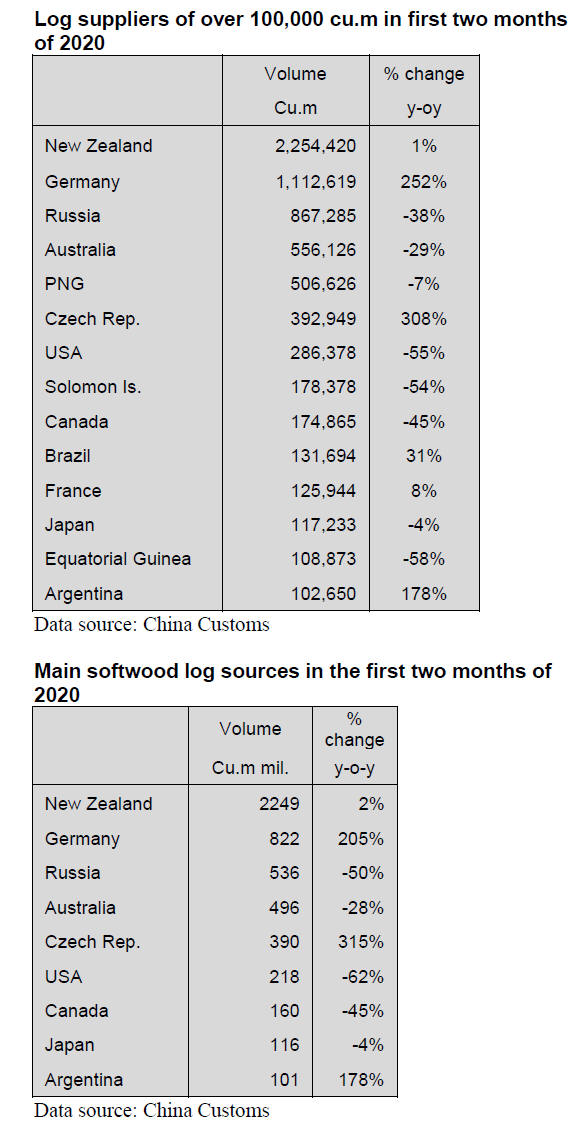
Decline both in volume and value of tropical
hardwood
log imports
Tropical log imports in the first two months of 2020
amounted 1.30 million cubic metres, down 26% year on
year and accounted for 17% of the national total.
In the first two months of 2020, China imported tropical
logs mainly from Papua New Guinea (39%), Solomon
Islands (14%), Brazil (10%), Equatorial Guinea (8.4%),
the Republic of Congo (5.8%), Mozambique (5.5%),
Cameroon (4.7%), Suriname (2.9%), CAR (2.5%) and
South Africa (2.3%). Just 10 countries supplied 95% of
China¡¯s tropical log requirements in the first two months
of 2020.
Among top source countries for tropical hardwood log
imports, imports from Surinam and the CAR jumped
138% and 136% to 38,000 cubic metres and 33,000 cubic
metres respectively.
The volume of log imports from Brazil and South Africa
also rose 31% and 15% to 132,000 cubic metres and
30,000 cubic metres respectively.
However, most of countries from which tropical log
imports declined greatly included Equatorial Guinea (-
58%), Solomon (-54%), the Republic of Congo (-45%)
and Cameroon (-42%).
Before their log export bans Laos and Myanmar were a
major source of tropical logs for China. However, China¡¯s
log imports from Laos in the first two months of 2020 fell
to just 5,602 cubic metres valued at US$8.04 million,
down 59% in volume and 50% in value. China¡¯s log
imports from Myanmar fell to just 434 cubic metres
valued at US$0.58 million, down 82% both in volume and
in value.

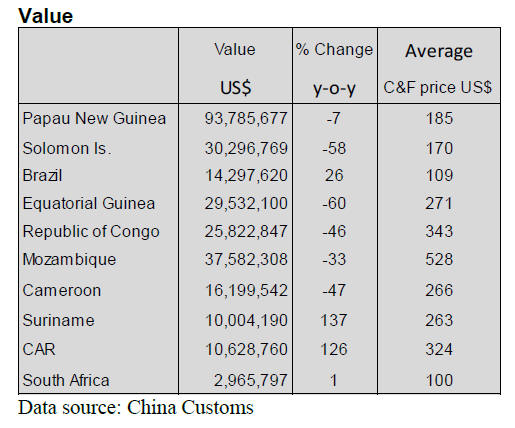
Sharp rise in tropical log imports through
Qingdao
Port
In the first two months of 2020, 74% of imported tropical
logs arrived at three major ports, Zhangjiagang, Qingdao
and Jingjiang ports. The volume of tropical logs handled at
Qingdao Port rose over 400% year on year to 324,000
cubic metres valued at US$D74 million.
However, tropical log imports through Zhangjiagang port
and Jingjiagn port were 400,000 cubic metres and 255,000
cubic metres valued at US$97.46 million and US$67.43
million cubic metres respectively all down from a year
earlier.
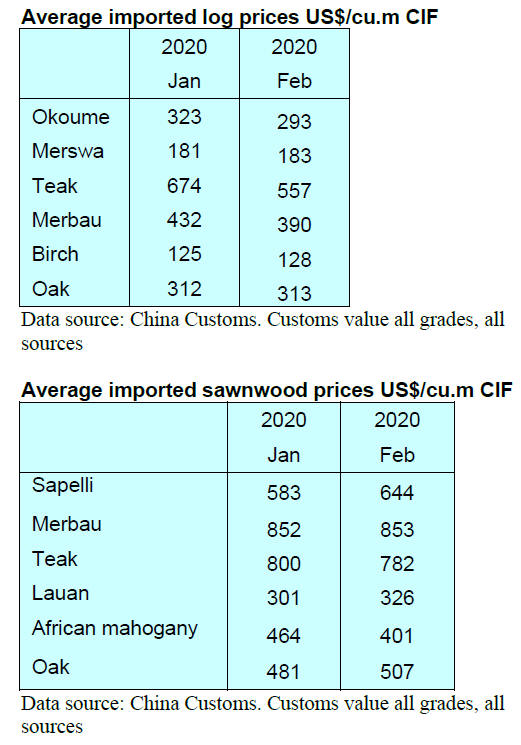
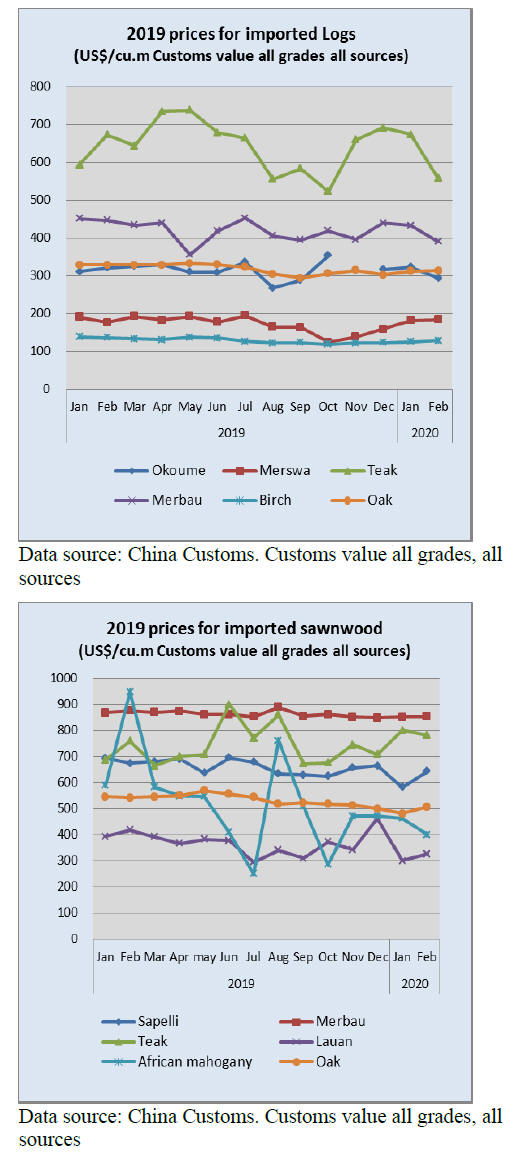
|